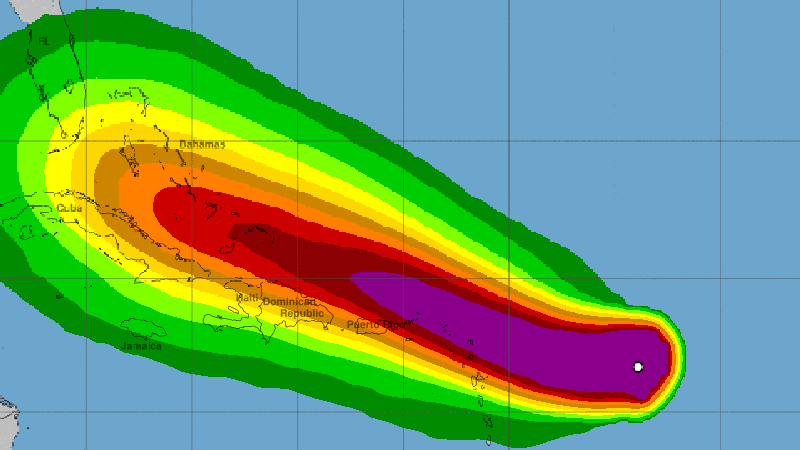 MIAMI, FLORIDA - Hurricane Irma, the most powerful storm to form in the open Atlantic Ocean, made landfall in the Caribbean early Wednesday and barreled toward Puerto Rico on a path that may bring it ashore in Florida and destroy so much property that damages may surpass Hurricane Katrina.
MIAMI, FLORIDA - Hurricane Irma, the most powerful storm to form in the open Atlantic Ocean, made landfall in the Caribbean early Wednesday and barreled toward Puerto Rico on a path that may bring it ashore in Florida and destroy so much property that damages may surpass Hurricane Katrina.Irma has sent cruise lines and insurance stocks plunging, with Barclays Plc estimating insured losses in a worst-case scenario at $130 billion. Natural gas slid on speculation that the storm will wipe out demand for the power-plant fuel, and orange and cotton futures surged on potential crop damage. The eye of the storm was passing over Barbuda, the U.S. National Hurricane Center said in an advisory at 2 a.m. New York time.
Irma comes less than two weeks after Hurricane Harvey smashed ashore in Texas, knocking offline almost a quarter of U.S. oil refining capacity and causing widespread damage, power outages and flooding. While the latest models show the latest storm veering away from gas and oil platforms off the coast of Texas and Louisiana, sparing Houston more devastation, it threatens to wreak havoc upon the Caribbean islands and Florida.
Irma “is the kind of storm where you get thousands of lives lost,” said Chuck Watson, a Savannah, Georgia-based disaster modeler with Enki Research. “This is not going to be the big slow-motion flood like Harvey -- this is a real, honest-to-God hurricane.”
Irma’s top winds were 185 miles (300 kilometers) an hour late Tuesday, making the system a Category 5, the highest measure on the five-step Saffir Simpson scale. It’s on track to strike or graze Caribbean islands from Antigua to Puerto Rico through Wednesday, and Cuba by Saturday, the U.S. National Hurricane Center said.
Were Irma to hit Miami with the same force as a Category 4 storm that struck in 1926, insured losses would reach $125 billion to $130 billion, Jay Gelb, an analyst at Barclays wrote in a note. Uninsured losses would be on top of that. Losses from Katrina, both insured and uninsured, reached $160 billion in 2017 dollars after it slammed into New Orleans in 2005, according to the U.S. National Centers for Environmental Information.
Losses across the Caribbean could easily reach $8 billion to $10 billion, Watson said. The islands that take a direct hit could be destroyed and San Juan, Puerto Rico, could be grazed by winds of at least 111 miles per hour.
$200 Billion
While it’s too early to say the exact track toward Florida, some damage modeling for a direct hit on Miami reach into the $200 billion range, he said.
The Rising Cost of Natural Disasters
Florida is the world’s largest producer of orange juice after Brazil, with most of the state’s crop located in the lower two-thirds of the peninsula. Orange juice for November delivery rose 6.2 percent to $1.45 a pound on ICE Futures U.S. Tuesday. Cotton jumped by the 3-cent exchange limit, or 4.2 percent, to 74.88 cents a pound.
“Our biggest concern is Florida citrus,” said Joel Widenor, co-founder of Commodity Weather Group LLC in Bethesda, Maryland. “There is big enough fruit on the trees that the fruit could drop off, it could literally get blown off.”
Three Hurricanes
Only three Category 5 hurricanes have hit the contiguous 48 U.S. states, according to Weather Underground: The Labor Day Hurricane of 1935 that devastated the Florida Keys, Hurricane Camille in 1969 and Hurricane Andrew that cut across Florida in 1992.
Why We Expect More Havoc From Hurricanes Like Harvey: QuickTake
While a ridge area of high pressure over the Gulf of Mexico may cause Irma to take a sharp right toward Florida once it reaches Hispaniola, Bloomberg New Energy Finance meteorologist Shunondo Basu cautioned, “Computer model tracks beyond 72 hours can shift, especially when a storm is over a body of water.”
In other storm news:
- NuStar Energy LP shut its St. Eustatius oil terminal while the Dominican Republic’s Refidomsa refinery may shut Wednesday.
- A strike on Florida would be the first time since 1964 that the U.S. was hit by back-to-back storms of Category 3 or more and only the second time since 1851, said Bob Henson, a meteorologist with Weather Underground in Boulder, Colorado.
- Insurance provider XL Group Ltd. dropped 5.8 percent in New York Tuesday, while Everest Re Group Ltd. declined 6.9 percent. Universal Insurance Holdings Inc., which sells more homeowners’ coverage in Florida than any other carrier, plunged 15 percent.
- U.S. natural gas futures dropped the most in more than a month.


